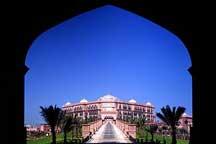 Apr. 16, 2025
Apr. 16, 2025
Weather
The Uygur ethnic minority
2009-08-07 11:40 BJTThe Uygurs made rapid socio-economic and cultural progress between the ninth and the 12th centuries. Nomadism gave way to settled farming. Commercial and trade ties with central China began to thrive better than ever before. Through markets, they exchanged horses, jade, frankincense and medicines for iron implements, tea, silk and money. With the feudal system further established, a land and animal owners' class came into being, comprising Uygur khans and Bokes (officials) at all levels. After Islam was introduced to Kaxgar in the late 10th century, it gradually extended its influence to Shache (Yarkant) and Yutian, and later in the 12th century to Kuya and Yanqi, where it replaced Shamanism, Manichae, Jingism (Nestorianism, introduced to China during the Tang Dynasty), Ao'ism (Mazdaism) and Buddhism, which had been popular for hundreds of years. Western Region culture developed quickly, with Uygur, Han, Sanskrit, Cuili and Poluomi languages, calendars and painting styles being used. Two major centers of Uygur culture and literature -- Turpan in the north and Kaxgar in the south -- came into being. The large number of government documents, religious books and folk stories of this period are important works for students of the Uygur history, language and culture.
In the early 12th century, part of the Qidan tribe moved westward from north-east China under the command of Yeludashi. They toppled the Hala Khanate established by the Uygurs, Geluolu and other Turkic tribes in the 10th century, and founded the Hala Khanate of Qidan (Black Qidan), or Western Liao as it is now referred to by historians. The state of Gao Chang became its vassal state. After the rise of the Mongols, most of Xinjiang became the territory of the Jagatai Khanate. In the meantime, when many Hans were sent to areas either south or north of the Tianshan Mountains to open up waste land, many Uygurs moved to central China. The forefathers of the Uygurs and Huis in Changde and Taoyuan counties in Hunan Province today moved in that exodus. The Uygurs exercised important influence over politics, economy, culture and military affairs. Many were appointed officials by the Yuan court and, under the impacts of the Han culture, some became outstanding politicians, military strategists, writers, historians and translators.
The Uygur areas from Hami in the east to Hotan in the south were unified into a greater feudal separatist Kaxgar Khanate after more than two centuries of separatism and feuding from the late 14th century. As the capital was moved to Yarkant, it was also known as the Yarkant Khanate. Its rulers were still the offspring of Jagatai. During the early Qing period, the Khanate was a tributary of the imperial court and had commercial ties with central China. After periods of unsteady relations with the Ming Dynasty, the links between the Uygurs and ethnic groups in central China became stronger. Gerdan, chief of Dzungaria in northern Xinjiang, toppled the Yarkant Khanate in 1678 and ruled the Uygur area. The Qing army repelled in 1757 (the 22nd year of the reign of Emperor Qian Long) the separatist rebellion by the Dzungarian nobles instigated by the Russian Tsar, and in 1759 smashed the "Batu Khanate" founded by Poluonidu and Huojishan, the Senior and Junior Khawaja, in a separatist attempt.
The Qing government introduced a system of local military command offices in Xinjiang. It appointed the General in Ili as the highest Western Regional Governor of administrative and military affairs over northern and southern Xinjiang and the parts of Central Asia under Qing influence and the Kazak and Blut (Kirgiz) tribes. For local government, a system of prefectures and counties was introduced.
The imperial court began to appoint and remove local officials rather than allowing them to pass on their titles to their children. This weakened to some degree the local feudal system. The court also encouraged the opening up of waste land by garrison troops and local peasants, the promotion of commerce and the reduction of taxation, which were important steps in the social development of Uygur areas.
Xinjiang was completely under Qing Dynasty rule after the mid-18th century. Although political reforms had limited the political and economic privileges of the feudal Bokes (lords), and taxation was slightly lower, the common ethnic people's living standards did not change significantly for the better. The Qing officials, through local Bokes, exacted taxes even on "garden trees." The Bokes expanded ownership on land and serfs, controlled water resources and manipulated food grain prices for profit.
Harsh feudal rule and exploitation gave rise to the six-month-long Wushi (Uqturpan) uprising in 1765, the first armed rebellion by the Uygur people against feudalism. With the aim of preserving their rule and getting rid of Qing control, Uygur feudal owners made use of struggles between religious factions to whip up nationalism and cover up the worsening class contradictions. Zhangger, grandson of the Senior Khawaja, a representative of those owners, under the banner of religion and armed with British-supplied weapons, harassed southern Xinjiang many times from 1820 to 1828, but failed to win military victory.
 Mail
Mail Share
Share Print
Print


 Video
Video









 2009 China Central Television. All Rights Reserved
2009 China Central Television. All Rights Reserved